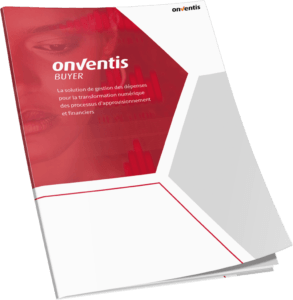Guided Buying: Simplifying Procurement Processes
Have you ever experienced this? You were just supposed to quickly order supplies for your printer cartridges. But thanks to the confusing catalog and the new requirements for supplier selection, it takes forever.
Procurement in companies can be a complex matter. There are often numerous approval processes and guidelines to follow to ensure compliance. This is where “Guided Buying” is a modern solution that revolutionizes and optimizes the procurement process.

Guided Buying: Simplifying Procurement Processes
Have you ever experienced this? You were just supposed to quickly order supplies for your printer cartridges. But thanks to the confusing catalog and the new requirements for supplier selection, it takes forever.
Placing compliant orders for a company can be challenging and can cost a lot of time and nerves. Procurement in companies can be a complex matter. There are often numerous approval processes and guidelines to follow to ensure compliance. This can lead to delays and inconvenience. This is where “Guided Buying” is a modern solution that revolutionizes and optimizes the procurement process.
What is Guided Buying?
Guided Buying is the principle of guiding employees through the purchasing process by customizing the catalog to an individual or even a group of individuals. As procurement activities become more complex due to purchasing cost limits, preferred suppliers, and framework agreements, the need for efficient purchasing processes increases. Guided Buying ensures strict adherence to procurement guidelines and enables easy access to other administrative processes in companies.
When users log into the e-procurement system, they are shown various tabs tailored to the user. Each employee can click on these tabs and place a fully compliant order by following the path from searching for the product to placing the order. Guided Buying is a powerful tool that optimizes the procurement process while ensuring adherence to guidelines. It revolutionizes purchasing by making procurement processes more efficient and convenient while saving costs in the long run.
What are the benefits of guided buying in companies?
Guided Buying offers a variety of benefits in the area of procurement in companies and can contribute to a more efficient and cost-effective procurement strategy. Here are some of the key reasons for implementing Guided Buying:
- Usability: Guided Buying makes the procurement process much easier for employees by providing an intuitive and user-friendly interface. Through clear guidelines and recommendations, users are supported in their purchases, improving their experience. At the same time, this helps to keep users on the e-procurement platform and avoid making purchases without involving the purchasing organization.
- Compliance: Guided Buying enables companies to better enforce compliance guidelines. By introducing predefined catalogs and suppliers, it is possible to ensure that purchases comply with the specified guidelines. This minimizes the risk of violations of internal and external regulations.
- Cost savings: Maverick buying is a costly problem in procurement. Purchases that do not involve the purchasing department drive up costs. Reasons include the non-utilization of negotiated supplier contracts and a lack of volume discounts. By directing purchases to preferred suppliers or contracts that have already been negotiated, companies can use these negotiated conditions and take advantage of them. This enables them to achieve cost savings and uncover potential savings while at the same time avoiding wild purchasing.
- Increased efficiency: Maverick buying is often caused by lengthy and complex processes that affect the purchasing experience. Automating procurement processes and using guided buying can maximize efficiency by reducing the manual workload, accelerating the entire procurement cycle and minimizing errors through standardized processes. This makes the purchasing process more targeted, faster, and more effective!
- Transparency: Guided Buying offers a transparent view of the entire procurement process. By clearly defining the procurement process, employees deviate less from it so that all purchases are recorded according to the rules. This allows companies to keep track of spending, perform analysis, and make informed decisions for future procurement strategies.
- Supplier management: By directing purchases to preferred suppliers, cooperation with strategically important suppliers can be strengthened. Users only buy from verified and selected suppliers, which can significantly reduce the maverick buying rate and strengthen long-term partnerships while improving the company’s negotiating position.
Creating a Guided Purchasing Experience with Onventis
With the Onventis all-in-one procurement software, the company creates a holistic, digital, and guided buying experience for all employees. Guided Buying in the system allows people to be guided through internally created and vetted catalogs to ensure employees don’t “bypass the procurement organization” when shopping. Here’s how it works:
- Individual catalogs: With the introduction of the software, the catalogs are determined together with the purchasing team and suppliers are integrated. Over time, the catalogs grow and, with them, the product range for users so that they can find everything they need in the system. These catalogs can be further customized in the next step to guide users through the system and experience the simplified purchasing process.
- Categorization and adaptation of catalogs: When an employee not part of the purchasing department logs into the system, they are presented with a special “Guided Buying” catalog. This catalog is designed to guide the employee through the product range with the help of directories and bundling and to direct them to their desired product or service. The main objective is to keep the user within the software and motivate them to purchase from verified suppliers within the negotiated contracts. Categorization is based on various criteria or directories that the companies can individually define.
- Inquiry forms: If the user cannot find the desired item in the catalog, sending a free text form to the purchasing department is possible. These forms can also be structured like a catalog and categorized by topic. For example, suppose a user is looking for training courses or workshops and fills out the corresponding request form. This is then sent to the relevant purchasing department and recorded there as a requirement so that the department can take care of the procurement. The user then receives the desired product or service with the approval of the purchasing department.
- Integration with Amazon Business: Onventis enables searching and ordering via Amazon Business to expand the internal catalogs. The software connects to the Amazon Business account and places orders for goods from Amazon Business directly in the Onventis system. This ensures that users remain on the platform and can still procure on shared platforms such as Amazon Business.
Onventis is committed to making the purchasing process as simple as possible for users while adhering to compliance guidelines. Users stay on the software and don’t just shop anywhere but adhere to the rules set by the purchasing process.
Schedule a live demo to learn more about our guided purchasing experience and increase the efficiency of your procurement!
Weitere BlogsMore BlogsMeer blogs




